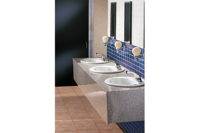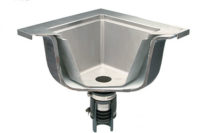With the risk of being smacked in the head by a 25-lb. king salmon careening through the air, it’s no surprise Seattle’s 100-year-old Pike Place Market may be best known for its charismatic fishmongers. And, of course, purveyors of morsels and spirits.
Among the many food vendors at Pike Place Market, fried food isn’t hard to find and the market’s waste drainage sees the side effects. Over the decades, the market has grown and so has the demand for fried food. Each new deep fryer puts additional strain on the drainage system.
Through the years, according to MacDonald Miller Facility Solutions Plumbing Superintendent Kevin Vincent, cast-iron pipe corroded and PVC was incompatible. As a result, vendors are all too familiar with the challenges and expense of drain maintenance and replacement.
As one vendor says, “We were in a state of perpetual decay knowing that the next round of pipe repair or replacement was just around the corner.”
Three years ago, the Pike Place MarketPreservation and Development Authority concluded that a solution must be found.
Night work
Vincentexplains all tenants at Pike Place Market that had grease-producing fixtures were responsible for coming to the Tacoma, Wash.-based firm to replace their waste drain pipe with Blücherstainless-steel pipe. MacDonald Miller provides mechanical engineering, design-build construction, custom metal fabrication, building system service and maintenance and energy-management services.
“It was a three-phase project at a breakneck pace,” he says.
Work started in 2008 and wrapped up last fall. Under normal working conditions the retrofit, which involved 30-plus restaurants, could have been completed in one year, but Pike Place is an interesting venue for service and replacement work.
The market opens early for breakfast, so restaurants need to have food ready for the table at 6 a.m., meaning a 5 a.m. start for many. Last call for food and drink is 1:30 a.m. That’s 20 hours a day for customers to purchase food, leaving few hours for a plumber to work on pipe. Pike Place is open 362 days a year.
“It was all-night work,” Vincent states. “Venue by venue, we had to tear out a section of old cast-iron or PVC pipe, install the new stainless-steel pipe and test it. We were in and out in less than four hours. Sometimes, the nighttime cleaning crews were an obstacle as well.”
All told, 7,650 linear ft. of Blücher stainless-steel pipe was installed during the three-phase replacement schedule. Once MacDonald Miller plumbers overcame the learning curve, it was smooth sailing. Using band clamps and working from only one end were the hardest things to acclimate as compared to using cast-iron pipe, Vincent says. MacDonald Miller crews were used to staking pipe or using thrust blocks to keep the heavy pieces in place.
“Unlike no-hub cast iron, you can’t start in the middle and work out,” Vincent explains. “You have to start at one end and work out. It’s not a big deal once you’re used to it.”
Vincent reports no requests for callbacks on the new pipe. “As far as we can tell, grease, oil and fat don’t stick to it,” he says.
Seafaring stainless
Given its geographic location, vendors at Pike Place truly can boast about the freshness of their fish. Seattle is a hub for the seafood market, whether it’s caught locally off the coast, in Canada or north in the frigid seas off Alaska.
The Bering Sea is a billion-dollar fishery for the United States and more than half that is on the Russian side. But the haul doesn’t come easy, as the TV series “The Deadliest Catch” has shown. It takes strong men and stronger boats. Pike Place is about 25 nautical miles from http://www.martinacship.com/J.M. Martinac Shipbuilding Corp., where some of the world’s finest tug and commercial fishing vessels are assembled.
Building boats isn’t like building houses. J.M. Martinac typically builds one or two vessels a year, depending on complexity. At the moment, the entire shipyard is focused on the Northern Leader – a $25 million, 184-ft. longline fishing boat. When it’s done, it’ll be one of the largest of its type on the Bering Sea.
“We’ve built ships up to 250 ft. long,” says Bob Stonack, purchasing manager for J.M. Martinac. “Tuna seiners, fireboats, naval tug boats; we build them from scratch right here in Tacoma.”
No matter where Martinac ships are deployed, they all share one thing in common. Seafaring components take a beating and need to hold up in the long run. It’s a risky business testing one’s mettle against the rigors of the sea. No exceptions are made for a ship’s plumbing.
Each vessel uses hundreds of feet of stainless pipe, mostly fastened to mounts welded to the underside of the deck. The pipe runs back and forth overhead, taking fluid where it needs to go. It’s just one critical component of the ship that allows crew members to focus on their often daunting tasks.
“From past experiences, we prefer Blücher pipe for black and graywater systems onboard our boats,” Stonack says. “It’s lighter than steel and lasts much longer. To my knowledge, we’ve never had an issue with it.”
Aviation-grade waste drainage
The Seattle-Tacoma International Airport provides even more examples of stainless in Seattle.
Like other large airports, Sea-Tac offers a host of destinations for millions of travelers each year. Many options are available for those who dine en route.
Thoughts of food-related waste drainage rarely occur to weary travelers while patronizing airport restaurants. But the high concentration of dining facilities makes it a pertinent issue, and Sea-Tac is no exception.
“We have nearly 50 restaurants in the airport,” says Ken Warren of Port of Seattle, the authority managing international trade and travel in King County, Wash. “The sheer quantity of soda, syrup, juice, dairy products and other corrosive cooking-related liquids that leave through the airport’s waste piping takes its toll.”
The cast-iron pipe the airport had been using lasted four or five years before it needed to be replaced because of corrosion, he says. In 2004, airport maintenance authorities were introduced to the Blücher stainless-steel product.
“It’s not like we shut the place down and replaced all pipe at once. That won’t fly in an airport,” Warren notes. “The section of pipe serving a restaurant gets replaced when that vendor’s contract is renewed. It’s written into the lease as part of the cost. Sometimes tenants don’t like it, but those are the terms if you want to do business at Sea-Tac.”
In-terminal caterers absorb the replacement cost to change from the cast-iron pipe to stainless-steel pipe. To date, no issues have been reported with the stainless-steel pipe and no schedule for replacement has been issued – a huge relief for airport food vendors.
“Understandably, there was initially a lot of resistance based on the replacement cost,” Warren says. “The fact is we see a payoff in three to five years. The less downtime there is, the better; especially in an airport terminal.”
The right decision
Over the past eight years, more than a dozen plumbing companies have worked on changing cast-iron pipe out for stainless at Sea-Tac. Each time a restaurant is retrofitted, between 100 and 200 linear ft. of pipe is replaced. Pipe diameters of 2 in. to 4 in. are used, increasing as it makes its way down to the below-grade, Schedule 80 high-density polyethylene pipe.
Warren notes the stainless-steel pipe has proven to be rather resilient. He cites the example of a utility van that smashed into a vertical section of 4-in. stainless-steel pipe in the garage bay on the lower level of the airport.
“It takes a hit and keeps going,” he says. “It’s had a big dent in it for three years and hasn’t caused a problem.”
Warren adds there was a feeling of the unknown when the replacements first started in 2004. As the years have gone by, that feeling has changed to one of confidence in the retrofit method.
“It was a leap of faith,” he says. “We saw the price increase for the new material, but we compared that to the cost of constantly replacing the cast iron. The advantages were apparent. On paper we could see a quick payback, but we weren’t sure of the new pipe’s performance. Nine years later we all agree we made the right choice.”
Dan Checri is the national sales manager for Watts Water Technologies.






